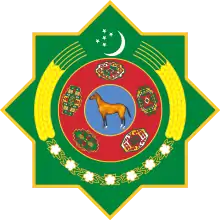1994 Turkmen presidential term referendum
A referendum on extending President Saparmurat Niyazov's term until 2002 was held in Turkmenistan on 15 January 1994.[1] Official results showed that the proposal was approved by 99.99% of voters, with a 100% turnout.[1]
 |
|---|
Background
In January 1990, Niyazov was elected to the Supreme Soviet of the Turkmen Soviet Socialist Republic and became its Chairman.[1][2][lower-alpha 1] Two months later, he would be elected by the Supreme Soviet for the new office of President.[1] Following on the footsteps of his predecessor(s), Niyazov prevented Gorbachev-era reforms from having any tangible effect on what was one of the most conservative federal republic of USSR.[1][2][lower-alpha 2] Opposition groups were routinely disbanded and members exiled on charges of anti-Soviet activities.[2] In October 1990, his Presidency was unanimously confirmed by the masses.[1]
Upon a reluctant independence in October 1991, a new constitution promulgated a presidential government.[2][3] The next year, Niyazov was re-elected unopposed as the (acting) President, winning over 98% of the vote.[1] On the heels of these victories, Niyazov went further in manifesting a totalitarian regime based on a cult of personality.[1][2][3]
Conduct
100% of the registered voters (1,959,637) participated in the referendum.[1]
Results
| Choice | Votes | % |
|---|---|---|
| For | 1,959,408 | 99.99 |
| Against | 212 | 0.01 |
| Invalid/blank votes | 17 | – |
| Total | 1,959,637 | 100 |
| Source: Neytralny Turkmenistan.[1] | ||
Legacy
The promised elections were not held in 2002, as Niyazov was declared President for life by the Assembly on 28 December 1999.[1] He subsequently ruled until his death in 2006.
Notes
- Niyazov was handpicked by Gorbachev into elite politics when he replaced Muhammad Gapusov as the first secretary of Ashgabat Communist Party.[2] This replacement was part of the Central Asian purges, executed in the wakes of Uzbek cotton corruption scandal.[2]
- Niyazov shifted blame for all evils that plagued the republic from the Supreme Soviet to Moscow.[2] This allowed him to have Turkmen subjects wary of Moscow's ways and avoid enacting any reform concerning the state apparatus.[2]
References
- Nohlen, Dieter; Grotz, Florian; Hartmann, Christof (2001-11-15). Elections in Asia and the Pacific: A Data Handbook. Oxford University Press. doi:10.1093/019924958x.003.0022. ISBN 978-0-19-924958-9.
- Al-Bassam, Kareem (1997). "The Evolution of Authoritarianism in Turkmenistan". Demokratizatsiya: The Journal of Post-Soviet Democratization. 5 (3): 386–405.
- Anderson, John (1995-12-01). "Authoritarian political development in Central Asia: The case of Turkmenistan". Central Asian Survey. 14 (4): 509–527. doi:10.1080/02634939508400922. ISSN 0263-4937.